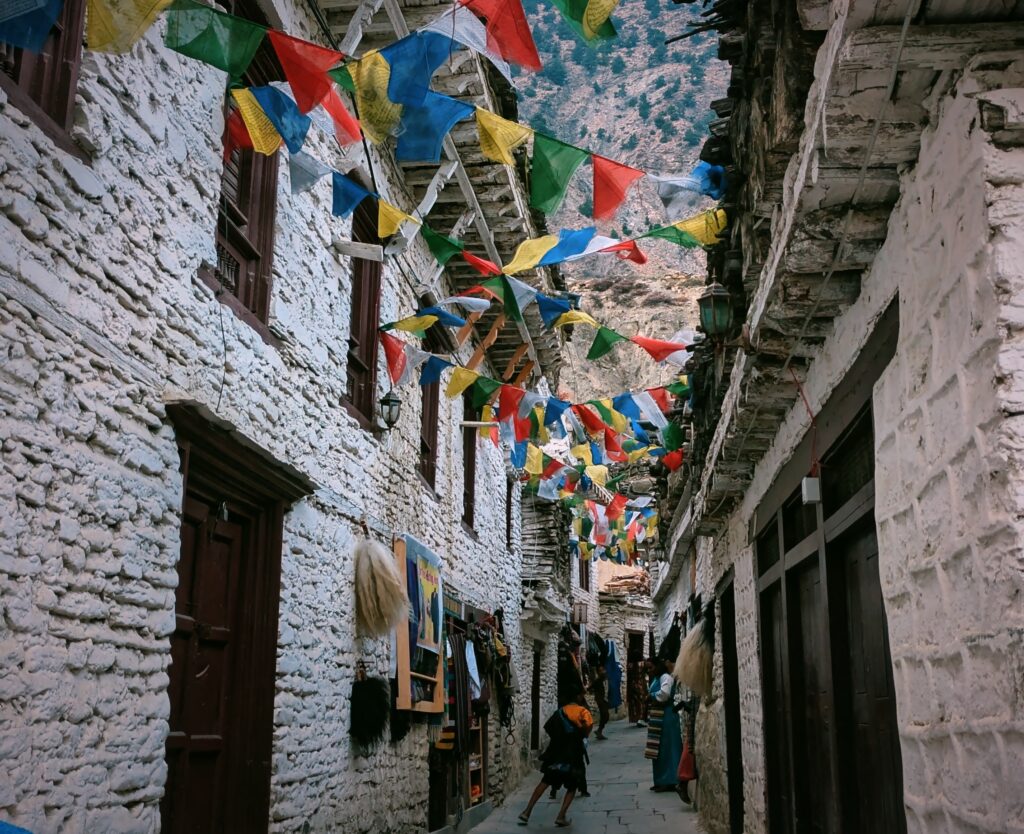🏞️ Introduction: Where Is Marpha Village?
Nestled in the heart of Mustang, Nepal, Marpha Village is a charming mountain settlement located in the Lower Mustang region. Perched at an altitude of around 2,700 meters (8,860 feet), it serves as a scenic gateway to the sacred Muktinath Temple and the starting point for treks like the Dhaulagiri Circuit. Known for its whitewashed stone houses, apple orchards, and strong Tibetan cultural influences, Marpha is a peaceful stop that offers stunning views of the Himalayan landscape.
This quaint village is not only a hub for trekkers and pilgrims but also a place to experience traditional Tibetan-Nepali culture, with friendly locals, ancient monasteries, and a unique blend of natural beauty and spirituality.
“Marpha Village lies in the heart of Mustang, a culturally rich and geographically stunning region of Nepal. For travelers seeking detailed information about Mustang’s attractions, travel tips, and permits, the Official Nepal Tourism Board’s Mustang page is an excellent resource.”
🏔️ A Village Rooted in Tibetan Culture
Marpha is home to the Tibetan-influenced Thakali people, who have preserved their traditional lifestyle for generations. Prayer flags flutter over rooftops, and the soothing hum of spinning prayer wheels welcomes you as you walk through the village. The locals are warm, hospitable, and deeply spiritual—something you’ll feel in the quiet presence of the Marpha Monastery, perched above the village, watching over its people.
🌄 The Scenic Beauty of Simplicity
What makes Marpha so captivating isn’t just its strategic location—it’s the village itself. The uniform white houses, built from local stones and stacked with firewood on their roofs, shine brightly in the Himalayan sun. Surrounded by arid cliffs, deep gorges, and snow-dusted peaks, Marpha’s scenery is nothing short of poetic.
🚙 My Journey to Marpha
I’ve shared a bit about how I arrived here in my Muktinath Postcard blog, but Marpha Village deserves a story of its own. Whether you’re heading to Muktinath, exploring Lower Mustang, or venturing toward Upper Mustang, Marpha is an essential stop that deserves more than a passing glance.
Our friendly driver, familiar with every twist in Mustang’s winding roads, offered to make a short stop. “You should be able to walk through in 30 to 40 minutes,” he said, leaving us at the entrance and agreeing to pick us up at the other end. Wind tugged at our jackets and light rain drizzled as we entered—but Marpha had its own plans for us.
Just a few steps into the village, we were welcomed by a kind old Tibetan lady with a warm smile. At first, she offered to rent us traditional clothes, but soon she was doing much more—taking our photos, laughing with us, and pointing out places to explore. Her presence was a beautiful reminder of how hospitality in Marpha goes far beyond a sales pitch.
That initial 30-minute plan quickly turned into two hours of slow wandering and heartfelt conversations. The stillness of the stone lanes, the gentle buzz of village life, and the human warmth we encountered made it impossible to rush through. We came as visitors, but for those two hours, it felt like we belonged.
🧘♀️ Local Life and Exploring the Village
Wandering through Marpha Village feels like walking through a time-honored story. Though compact in size, every alleyway, every rooftop, and every smile reveals a rich, layered life steeped in Tibetan-influenced culture and tradition.
The narrow cobblestone streets twist through rows of whitewashed stone houses, each one trimmed neatly with stacks of firewood and tiny apple trees in bloom. As we moved deeper into the village, we were greeted by sights and sounds that made Marpha unforgettable—monks spinning prayer wheels, herbs drying on windowsills, and the warm laughter of children echoing against the stone walls.
There was so much more life here than we’d expected on what was supposed to be a short pit stop.
In fact, we found ourselves wishing we had stayed the night. The atmosphere had that rare quality of being both peaceful and alive. But as this stop wasn’t even in our original plan, maybe it’s the perfect excuse to come back—especially since Upper Mustang is still on my bucket list.
During our wandering, we noticed something curious—yak tails, hanging in shopfronts and doorways. Later, I learned they aren’t just decorative. In Tibetan and Himalayan traditions, yak tails (called “chamara”) are often used in Buddhist rituals as fly whisks, symbols of purity, and ceremonial objects. In homes or shops, they may also represent spiritual protection or good luck. Seeing them added yet another layer to the quiet mysticism of this village.
From shops selling yak wool scarves and prayer beads, to locals inviting us to sit for tea, Marpha was filled with gestures of openness. The kind of place where even an unplanned stop can feel like a homecoming.
🛍️ What to Buy in Marpha: Local Crafts and Souvenirs
While Marpha is best known for its peaceful alleys and apple orchards, it’s also a place where you can discover locally made treasures—from handcrafted items to bold flavors unique to the region.
1. Yak Wool Scarves and Shawls
Stay warm the traditional way with yak wool scarves and shawls, handwoven by local artisans. Soft, durable, and uniquely Himalayan, they make thoughtful souvenirs or long-lasting travel companions.
2. Prayer Flags, Beads, and Ritual Items
You’ll find prayer flags, mala beads, and singing bowls in small shops along the main lane. Some even sell chamara (yak tail whisks), often used in Tibetan Buddhist rituals for spiritual purity and protection.
3. Apple Products and Brandy
Marpha is famous for its apples. Be sure to try or take home dried apples, homemade jams, or the village’s legendary apple brandy. Locals often distill it themselves, and its smooth, warming kick tells you everything about Mustang’s high-altitude spirit.
4. Spices and Traditional Foods
We also came across something special—Timur, a fragrant Himalayan peppercorn also known as Sichuan pepper. Locals sell it whole, or as “Timur chop,” a spicy condiment or marinade mix that’s used in traditional cooking. It’s perfect for food lovers who want to bring Mustang’s bold flavors back to their kitchen.
5. Yak Meat Products
If you’re a fan of trying local delicacies, look for shops offering yak meat jerky or dried yak meat. It’s a staple for mountain communities—rich in protein, deeply flavorful, and often spiced with local herbs. It’s also a handy trekking snack if you’re heading further up the trails.
6. Handmade Textiles and Garments
From embroidered bags and belts to traditional Tibetan outfits (which we were kindly offered to try on by a friendly local lady!), Marpha has plenty of handmade textiles that reflect its cultural roots.
💡 Pro Tip:
While Marpha’s village shops offer charming local crafts and souvenirs, don’t miss the small market just outside the village entrance/exit. Here, you can find many goods at wholesale prices—perfect if you’re stocking up on spices, dried fruits, or trekking essentials. It’s a great spot to bargain and discover hidden treasures before continuing your journey.
🧭 Marpha as a Gateway: Where to Next?
Marpha isn’t just a beautiful village to explore—it’s also a vital gateway to several incredible destinations in Mustang and the greater Himalayas. Whether you’re a trekker, pilgrim, or cultural explorer, Marpha’s location makes it a perfect starting point or rest stop for your journey ahead.
🚶♂️ On the Way to Muktinath
One of the most popular reasons travelers pass through Marpha is en route to the sacred Muktinath Temple. This revered pilgrimage site, nestled at an altitude of 3,800 meters, draws visitors from across Nepal and Tibet alike. After a peaceful stay in Marpha, many set off towards Muktinath, enjoying spectacular mountain views along the way.
🏞️ Gateway to the Dhaulagiri Trek
Marpha also serves as a key access point for the Dhaulagiri Circuit Trek, a challenging but rewarding trail circling the majestic Dhaulagiri massif. Adventurers often use Marpha to rest, resupply, and acclimatize before heading into higher elevations and rugged terrain.
🌄 Exploring Upper Mustang
While Marpha lies in Lower Mustang, it’s a stepping stone to the mysterious and culturally rich Upper Mustang region, often called the “Last Forbidden Kingdom.” Treks from Marpha lead to ancient caves, monasteries, and unique Tibetan-influenced villages where time feels frozen.
🛤️ Connecting to Other Villages
Marpha is also well-connected by road and trails to other charming Mustang villages such as Jomsom, Tukuche, and Kagbeni—each offering their own distinctive culture and landscapes. Travelers often create loop routes starting or ending in Marpha to experience the full diversity of Mustang.
🌤️ Final Notes: Weather, Travel Tips, and More
When to Visit
The best time to visit Marpha and Mustang is during the spring (March to May) and autumn (September to November) seasons. During these months, the weather is generally clear, with moderate temperatures and minimal rainfall—perfect for trekking and exploring. Winters can be very cold with snow, while summers may bring some monsoon showers.
Weather Overview
Marpha sits at around 2,700 meters (8,860 feet), so expect cool mountain air year-round. Daytime temperatures in peak seasons usually range between 10°C to 20°C (50°F to 68°F), but nights can get chilly, especially in spring and autumn.
Travel Tips
Altitude: While Marpha is relatively low compared to higher Mustang areas, take it easy and stay hydrated to avoid altitude sickness if you’re coming from lower elevations.
Cash is King: ATMs are rare in Mustang, so carry enough cash for shopping and meals.
Respect Local Customs: Mustang’s Tibetan Buddhist culture is deeply spiritual. Dress modestly, ask permission before photographing people, and be respectful of monasteries and religious sites.
Connectivity: Mobile networks are spotty, and internet access is limited in the village. Enjoy the digital detox!
✈️ Continue the Journey with Me
Marpha was just one chapter in my Mustang adventure. If you’re curious about what came next, or want to dive deeper into the spiritual and scenic wonders of the region, here are some stories from the road:
Muktinath Magic: Discover the serene pilgrimage that stole my heart in my spiritual getaway to Muktinath.
Upper Mustang Calling: The mysterious landscapes and ancient culture of Upper Mustang are still on my bucket list—stay tuned for my next tale!
Travel is about the journey—and I’d love to share mine with you.

